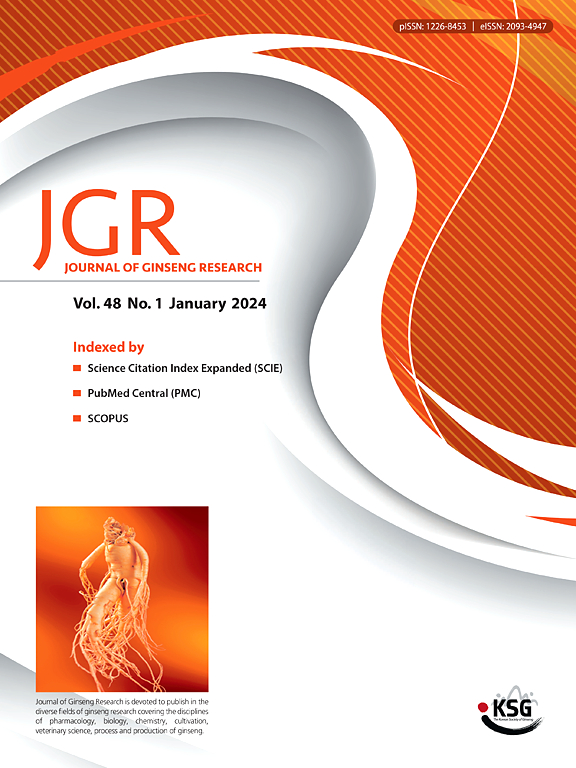Total saponins from Panax Japonicus regulate the ferritin heavy chain to reduce inflammation in aging adipose tissue by mediating iron metabolism
IF 6.8
2区 医学
Q1 CHEMISTRY, MEDICINAL
引用次数: 0
Abstract
Background
Inflammation is a key factor contributing to aging-related morbidities. Inflammation is intimately linked to the iron metabolism in macrophages, and ferritin heavy chain (Fth) is the basis of iron metabolism in macrophages. Regulating Fth to control iron metabolism may help to reduce inflammation in macrophages, which can ultimately help to alleviate certain aging-related diseases.
Methods
The effects of total saponins from Panax Japonicus (TSPJs) in the intervention of aging-related obesity were explored. The in vitro and in vivo models were established using RAW264.7 macrophage cells and naturally aging rats and mice. The inflammation, iron content, and gene expressions of the models were analyzed. Senescence was induced in RAW264.7 cells with adriamycin (ADR), and Fth knockdown was introduced to the models to investigate related mechanisms.
Results
TSPJs reduced the iron content in the macrophages and prompted M2 polarization, which affected the JNK signaling pathway (p < 0.05) and reduced the expression of inflammatory cytokines in adipose tissue.
Conclusion
TSPJs mediate the iron metabolism of macrophages via Fth to reduce aging-related inflammation of the adipose tissue.

参总皂苷通过调节铁蛋白重链,减轻老化脂肪组织的炎症反应
背景:炎症是导致衰老相关疾病的关键因素。炎症与巨噬细胞的铁代谢密切相关,铁蛋白重链(Fth)是巨噬细胞铁代谢的基础。通过调控铁的代谢,可能有助于减少巨噬细胞的炎症,最终有助于缓解某些衰老相关疾病。方法探讨日本参总皂苷(TSPJs)对衰老相关性肥胖的干预作用。采用RAW264.7巨噬细胞和自然衰老大鼠、小鼠建立体外和体内模型。对模型的炎症、铁含量及基因表达进行分析。用阿霉素(ADR)诱导RAW264.7细胞衰老,并在模型中引入第5次敲低(Fth knockdown),探讨相关机制。结果stspjs降低巨噬细胞铁含量,促进M2极化,影响JNK信号通路(p <;0.05),降低脂肪组织中炎性细胞因子的表达。结论tspjs通过Fth介导巨噬细胞铁代谢,减轻脂肪组织衰老相关炎症。
本文章由计算机程序翻译,如有差异,请以英文原文为准。
求助全文
约1分钟内获得全文
求助全文
来源期刊

Journal of Ginseng Research
CHEMISTRY, MEDICINAL-INTEGRATIVE & COMPLEMENTARY MEDICINE
CiteScore
11.40
自引率
9.50%
发文量
111
审稿时长
6-12 weeks
期刊介绍:
Journal of Ginseng Research (JGR) is an official, open access journal of the Korean Society of Ginseng and is the only international journal publishing scholarly reports on ginseng research in the world. The journal is a bimonthly peer-reviewed publication featuring high-quality studies related to basic, pre-clinical, and clinical researches on ginseng to reflect recent progresses in ginseng research.
JGR publishes papers, either experimental or theoretical, that advance our understanding of ginseng science, including plant sciences, biology, chemistry, pharmacology, toxicology, pharmacokinetics, veterinary medicine, biochemistry, manufacture, and clinical study of ginseng since 1976. It also includes the new paradigm of integrative research, covering alternative medicinal approaches. Article types considered for publication include review articles, original research articles, and brief reports.
JGR helps researchers to understand mechanisms for traditional efficacy of ginseng and to put their clinical evidence together. It provides balanced information on basic science and clinical applications to researchers, manufacturers, practitioners, teachers, scholars, and medical doctors.
 求助内容:
求助内容: 应助结果提醒方式:
应助结果提醒方式:


